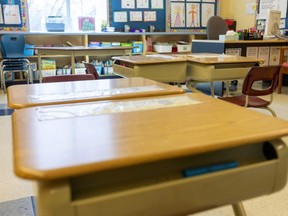Concerned about rising student absenteeism post-pandemic, the Thames Valley District school board has created an internal working group to target the problem.

Concerned about rising student absenteeism post-pandemic, the Thames Valley District school board has created an internal working group to target the problem. One way the board plans to respond is with a district-wide campaign, including a communication strategy, designed to create awareness about the issue and improve attendance rates.
Advertisement 2
Article content
Article content
WHY IS BEING ABSENT FROM SCHOOL A PROBLEM?
Persistent absenteeism is defined by Ontario’s Ministry of Education as a student missing 10 per cent or more of the school year, including both excused and unexcused absences.
“Since the pandemic (ended) it’s been an issue regionally, provincially, nationally and internationally,” said Kathryn Lambert, manager of professional services at the Thames Valley District school board.
High absence rates are a problem because attendance is a “significant indicator of high school graduation,” she said.
“We know graduating high school is a protective factor as an adult in terms of long-term physical, mental health and well-being indicators,” Lambert said.
As well, students with poor attendance are at increased risk of peer conflict and behavioral issues as well as anxiety and depression, she said.
Advertisement 3
Article content
WHERE IS THE DATA ON ABSENT STUDENTS?
In a January 2024 article on post-pandemic student absenteeism, Paul W. Bennett, director of the Schoolhouse Institute in Halifax, says while finding Canadian data “requires considerable digging,” raw data on student absenteeism in one school board (Hamilton Wentworth) shows absenteeism rose from three to four per cent in 2020 to between eight and 14 per cent in November 2022. Though the Thames Valley board says it doesn’t have recent data on student absenteeism, one study in the United Kingdom found one in five students are chronically absent from school and one in four parents believe it’s OK to skip school.
WHAT DOES THE LAW SAY ABOUT GOING TO SCHOOL?
In Ontario, children aged six to 18 must attend school. A person can be excused from school if they are sick or getting instruction elsewhere or if adequate transportation is not provided by their school board.
Advertisement 4
Article content
Other reasons included a student being expelled or suspended or absent due to religious holidays.
WHY ARE STUDENTS MISSING MORE SCHOOL?
Habits developed during periods of remote learning in the COVID-19 pandemic “became normalized,” Lambert says.
Parents and children became used to staying at home and still haven’t returned to their pre-pandemic routines, she said.
“When kids are learning remotely, families got out of those habits,” Lambert said. “We’re giving caregivers information about the importance of some of these habits to reset that.”
When there are barriers to a student’s attendance “we problem-solve those barriers,” she said.
“We are working with office staff, vice-principals and principals to ensure we are developing supportive relationships with families to talk about barriers to student attendance.”
Advertisement 5
Article content
WHAT HAPPENS IF A CHILD IS CHRONICALLY ABSENT
School staff reach out to the family to offer support and try to plan how to improve the student’s attendance, Lambert said.
If needed, the school refers the student to a social worker or attendance counselor who will continue to support the family and student in addressing barriers to school attendance, she said.
DID YOU KNOW?
If a student misses 15 days a year, by Grade 12 that would add up to missing an entire year of school.
That’s one of the messages Thames Valley hopes to get out to parents and guardians through its communication strategy, Lambert says.
“The reason why TVDSB is communicating with families and students about attendance is to provide information about the benefits of attending school,” she said.
Advertisement 6
Article content
The board is using email, newsletters and other media to get the message out about the “importance of resetting (COVID) habits,” she said.
“We really want families to understand the connection between students attending every day and student achievement,” associate director Riley Culhane said. “Sometimes there is a lack of understanding that those missed days accumulate and as a result students miss large portions of learning opportunities.”
THE FALLOUT
“Alarming rates of absenteeism suggest that parents as well as children do not prioritize school attendance to the degree they did a generation ago, when compulsory school attendance was generally accepted by a cross-section of school communities across the socio-economic spectrum,” says Bennett in his article on post-pandemic student absenteeism.
He claims the result will have “dire consequences for the life chances and employability of the pandemic generation.”
And Bennett calls convincing students and their parents to get back into the classroom “the strategic education issue of our time.”
Recommended from Editorial
Article content

